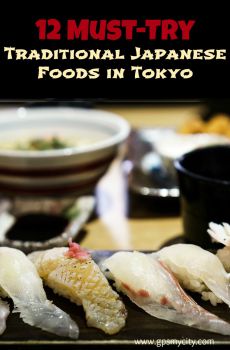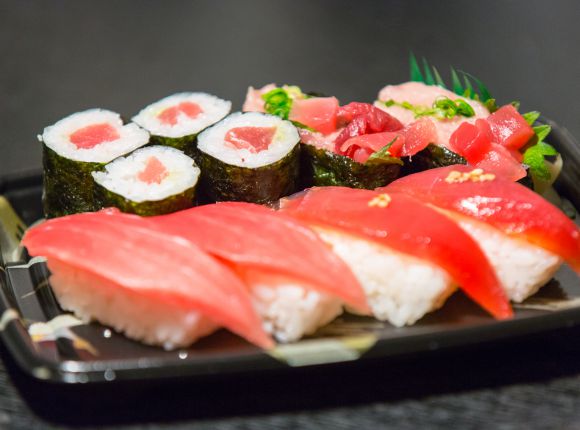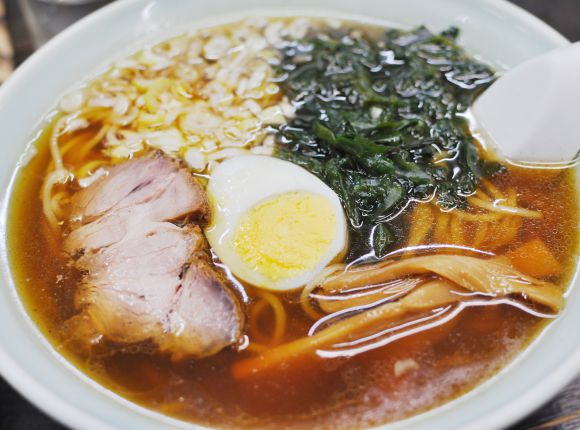
12 Must-Try Traditional Japanese Foods in Tokyo
Cuisine is an integral part of any local culture, and no trip to Tokyo is complete without tasting the authentic, Tokyo-made Japanese food. This directory offers information about the traditional dishes and drinks available in Tokyo to help visitors better understand the local food culture and make an informed decision when trying some of the local culinary delights!
(To visit the venues mentioned in this article, check out these Self-Guided Walking Tours in Tokyo)
1. Sushi

Image Courtesy of: IQRemix
Sushi is, perhaps, the most famous worldwide Japanese food. Although, these days, eating sushi is commonplace in many foreign destinations, a trip to Tokyo would not complete without trying this gastronomical delight in its homeland. Amid the variety of sushi available, there's a staple ingredient present in all - vinegared rice. Topped with various seafood, e.g. raw fish – Nigirizushi, it forms one the best-known types of sushi.
The origins of this dish date back to the 4th century BC; the original sushi of that time was called nare-zushi. The term "sushi" itself derives from a grammatical form that is no longer used in modern Japanese, and literally means "sour-tasting". Serving the dish is done in a simple Japanese manner, on wooden or lacquer plates, and usually involves dipping sushi in a soy sauce. Other key - side- ingredients include wasabi and pickled ginger.
The origins of this dish date back to the 4th century BC; the original sushi of that time was called nare-zushi. The term "sushi" itself derives from a grammatical form that is no longer used in modern Japanese, and literally means "sour-tasting". Serving the dish is done in a simple Japanese manner, on wooden or lacquer plates, and usually involves dipping sushi in a soy sauce. Other key - side- ingredients include wasabi and pickled ginger.
2. Ramen

Image Courtesy of: yoppy
Ramen is originally Chinese food that the Japanese have adapted to their taste. Nowadays, this is one of the staple dishes in Japanese cuisine. Ramen tastes different throughout the country; in Tokyo you can find ramen consisting of thin, curly noodles served in a chicken broth and flavoured with soy. The toppings are usually sliced pork, egg, spinach and nori. Ramen is a popular fast food that makes for an affordable meal in the city. There are types of ramen restaurants where you choose ramen you want at a vending machine by pressing the button to get a ticket, then give it the chef and wait for the ramen to be delivered to your table. Don't forget to make a slurping sound while eating ramen with your chopsticks, as this is something rather common (a sign of appreciation) and not at all impolite!
3. Tempura

Image Courtesy of: Toshihiro Oimatsu
Another traditional Japanese food, called Tempura, was introduced to Japan by the Portuguese missionaries in the 16th century. The dish comprises vegetables, seafood and other ingredients, all battered in eggs and flour, and then fried in vegetable oil to form a crispy texture. To absolutely enjoy the dish, it is best to try it at a specialized tempura restaurant – tempura-ya, although it is also served with common dishes, like soba or udon.
4. Sashimi

Image Courtesy of: Yumi Kimura
Sashimi is considered a Japanese delicacy, regarded by Japanese chefs as the finest dish in formal Japanese dining. In essence, it represents fresh, raw seafood or meat, thinly sliced and served with a soy sauce and other ingredients, such as wasabi or ginger - most commonly offered. Traditionally, sashimi is recommended as a first course, ahead of something strongly flavoured.
5. Sukiyaki

Image Courtesy of: ajari
Sukiyaki is a real treat for those passionate beef-lovers! It is usually cooked right at the table in a Japanese hot pot style (nabemono). Like most Japanese foods, Sukiyaki has some cooking variations. The most common ingredients used in Tokyo include vegetables, tofu and negi, all of which are added to the beef and cooked, mixed with soy sauce, sugar and mirin. To soak up the broth, boiled udon or soba is sometimes added at the end. Sukiyaki is considered to be a winter dish, most perfect for warming up eaters on the inside!
6. Soba

Image Courtesy of: Kennosuke Yamaguchi
Soba is a type of noodles made from buckwheat flour, which has been known as a traditional Japanese food since the Edo period (1603-1868). The Japanese have different opinions on how to best enjoy soba, but the chilled version or that cooked as a noodle soup are the two most popular. Soba is usually taken with a soy sauce, called tsuyu, placed on the side for dipping (cold soba), or boiled in it (hot soba). The most common type of chilled soba is Mori Soba. There are quite a few places in Tokyo to try good soba, from street vendors to markets to specialized restaurants. As with other Japanese dishes, slurping is an expected action!
7. Udon

Image Courtesy of: Takuma Kimura
Udon is quite similar to soba, in terms of being noodles, but these are made from wheat flour. As with soba, it can be served either cold or hot. The simplest hot dish is made in a broth, called kakejiru. A variety of toppings can be added, like scallions or prawns. This particular udon soup is known as Kake Udon, although there are many other types just as tasty!
8. Okonomiyaki

Image Courtesy of: Alpha
A totally Japanese comfort food, Okonomiyaki is a pancake filled with all sorts of things - mostly pork, shrimp or cabbage, - topped with mayonnaise, sauce and dried seaweed. The name is translated as something close to "whatever you like grilled", hence the multiple ingredients present in the dish. It is considered fast food and can be found at street vendors, although some restaurants also serve it, cooked right in front of you, or even let you try your hand and prepare it for yourself!
9. Chankonabe

Image Courtesy of: Jo del Corro
Chankonabe was originally cooked for sumo wrestlers to accommodate their weight gain diet. Nowadays, this dish has gained popularity among the general public in Tokyo and throughout Japan. Chankonabe is a hot pot dish made from chicken-based broth, vegetables, tofu and/or fish. The meal as such is protein-based and can be found at a number of specialized restaurants in the city, usually run by ex-Sumo wrestlers themselves. Sometimes, it is even served with rice and beer to increase calories.
10. Miso Soup

Image Courtesy of: Kim Ahlström
Miso soup is a traditional Japanese food, said to be the cornerstone of a nutritious local breakfast. It consists of dashi – a stock with added miso paste. Tofu is also usually added to the equation and, depending on the recipe, vegetables, meat and seafood can be used as well. This soup represents a high-protein mixture that balances floating ingredients with those sinking ones. Miso paste is a signature ingredient that defines miso soup as such; the texture and flavour of the soup is very much dependent on the type of miso paste used. In essence, Miso soup is a staple Japanese dish and an absolute must-try, when in Tokyo.
11. Unagi

Image Courtesy of: Jun Seita
Unagi is the Japanese word for "fresh eel". It is usually served as part of other dishes, such as unadon, in which unagi is placed on a bed of rice, or unakyu – sushi with unagi and cucumber. As an important part of Japanese cuisine, unagi deserves a good, long tasting. The eel itself is high in protein and vitamin A. There a number of restaurants in Tokyo specializing in unagi, usually recognizable by a street sign featuring the first character of the Japanese word unagi.
There is even a special day in Japan for eating unagi, the midsummer day of the Ox.
There is even a special day in Japan for eating unagi, the midsummer day of the Ox.
12. Sake

Image Courtesy of: Jouko Karvonen
Serving Sake is one of the ancient, authentic Japanese traditions, largely preceding the recorded history. In fact, the very term "Sake" means any alcoholic beverage, whereas the actual drink, to which the Westerners commonly refer as Sake, is called "nihonshu". The latter is an alcoholic, rice-based drink made in different flavours - banana, apple, spicy, chocolate, etc. It is served in small shots, called "choko", and is supposed to be taken either lukewarm (at room temperature) or heated.
Get GPSmyCity App for IOS or Android
You can read offline thousands of travel articles like this one in the "GPSmyCity: Walks in 1K+ Cities" app on Apple App Store or Google Play Store. The apps also offer city offline maps and GPS navigation to guide you to the places featured in the articles.
Walking Tours in Tokyo, Japan
Create Your Own Walk in Tokyo
Creating your own self-guided walk in Tokyo is easy and fun. Choose the city attractions that you want to see and a walk route map will be created just for you. You can even set your hotel as the start point of the walk.
Shibuya Walking Tour
The Shibuya district is a shopping and entertainment mecca for fashion-conscious and trendy teenagers. Synonymous with Japan's youth vogue and fun in general, the streets of Shibuya are lined with shops, boutiques, restaurants, and nightclubs. On weekends, crowds of youngsters converge here, dressed up in a myriad of colors and styles, set out to socialize and have a good time.
One of the... view more
Tour Duration: 2 Hour(s)
Travel Distance: 3.9 Km or 2.4 Miles
One of the... view more
Tour Duration: 2 Hour(s)
Travel Distance: 3.9 Km or 2.4 Miles
Ginza Shopping Tour
Often compared with New York's Fifth Avenue, Ginza is the most luxurious shopping district in Tokyo. Its two main avenues running through the area, Chuo-dori Street and Harumi-dori Street, are lined with high-end boutiques, enormous department stores, and flagship stores of renowned international brands carrying a wealth of merchandise, from fashion and jewelry to electronics and cosmetics.
... view more
Tour Duration: 1 Hour(s)
Travel Distance: 1.6 Km or 1 Miles
... view more
Tour Duration: 1 Hour(s)
Travel Distance: 1.6 Km or 1 Miles
Tokyo Imperial Palace Walking Tour
The Imperial Palace, the residence of the Japanese Emperor, is a vast expanse of green in the heart of Tokyo, surrounded by moats. The palace stands on the site previously occupied by the Edo Castle, in the 17th–19th centuries. While the royal residential compound is closed for visitors (except for two days a year – January 1st and December 23rd), a big part of the palace grounds, including... view more
Tour Duration: 2 Hour(s)
Travel Distance: 2.7 Km or 1.7 Miles
Tour Duration: 2 Hour(s)
Travel Distance: 2.7 Km or 1.7 Miles


















